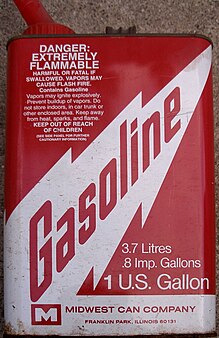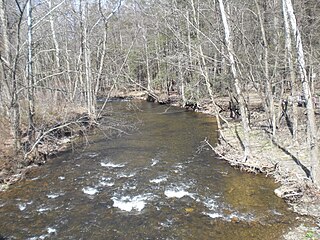Related Research Articles

The gallon is a unit of measurement for volume and fluid capacity in both the US customary units and the British imperial systems of measurement. Three significantly different sizes are in current use: the imperial gallon defined as 4.54609 litres, which is used in the United Kingdom, Canada, and some Caribbean nations; the US gallon defined as 231 cubic inches or about 3.785 L, which is used in the US and some Latin American and Caribbean countries; and the least-used US dry gallon defined as 1/8 US bushel (4.405 L).

The cubic inch is a unit of measurement for volume in the Imperial units and United States customary units systems. It is the volume of a cube with each of its three dimensions being one inch long.
The cubic foot is an imperial and US customary (non-metric) unit of volume, used in the United States, and partially in Canada, and the United Kingdom. It is defined as the volume of a cube with sides of one foot (0.3048 m) in length. Its volume is 28.3168 liters or about 1⁄35 of a cubic meter.
A cubic yard is an Imperial / U.S. customary unit of volume, used in the United States, Canada, and the UK. It is defined as the volume of a cube with sides of 1 yard in length.

In physics and engineering, in particular fluid dynamics and hydrometry, the volumetric flow rate is the volume of fluid which passes per unit time; usually represented by the symbol Q. The SI unit is m3/s. Another unit used is sccm.

A barrel is one of several units of volume applied in various contexts; there are dry barrels, fluid barrels, oil barrels and so on. For historical reasons the volumes of some barrel units are roughly double the volumes of others; volumes in common usage range from about 100 to 200 litres. In many connections the term "drum" is used almost interchangeably with "barrel".

The acre-foot is a unit of volume commonly used in the United States in reference to large-scale water resources, such as reservoirs, aqueducts, canals, sewer flow capacity, irrigation water, and river flows.

The Metolius River is a tributary of the Deschutes River in Central Oregon, United States, near the city of Sisters. The river flows north from springs near Black Butte, then turns sharply east, descending through a series of gorges before ending in the western end of the lake. The unincorporated community of Camp Sherman lies astride the southern end of the river. The name of the river comes from the Warm Springs or Sahaptin word mitula, meaning white salmon and referring to a light colored Chinook salmon and not a whitefish.

Big Wapwallopen Creek is a tributary of the Susquehanna River in Luzerne County, Pennsylvania, in the United States. It is approximately 23 miles (37 km) long and flows through Bear Creek Township, Fairview Township, Rice Township, Wright Township, Dorrance Township, Hollenback Township, Nescopeck Township, and Conyngham Township. The watershed of the creek has an area of 53.2 square miles (138 km2). The creek has three named tributaries: Balliet Run, Watering Run, and Bow Creek. The creek is designated as a Coldwater Fishery and a Migratory Fishery and is also Class A Wild Trout Waters for part of its length. However, a portion is considered to be impaired by organic enrichment and/or low levels of dissolved oxygen and its pH ranges from moderately acidic to slightly alkaline.

A compressed air foam system (CAFS) is used in firefighting to deliver fire retardant foam for the purpose of extinguishing a fire or protecting unburned areas.
A cubic metre per second is a derived SI unit of volumetric flow rate equal to that of a stere or cube with sides of one metre in length exchanged or moving each second. It is popularly used for water flow, especially in rivers and streams, and fractions for HVAC values measuring air flow.
The flow coefficient of a device is a relative measure of its efficiency at allowing fluid flow. It describes the relationship between the pressure drop across an orifice, valve or other assembly and the corresponding flow rate.
An important parameter in wet scrubbing systems is the rate of liquid flow. It is common in wet scrubber terminology to express the liquid flow as a function of the gas flow rate that is being treated. This is commonly called the liquid-to-gas ratio and uses the units of gallons per 1,000 actual cubic feet or litres per cubic metre (L/m3).
Airwatt or air watt is a measurement unit of the effectiveness of vacuum cleaners which refers to airflow and the amount of power (watts) a vacuum cleaner produces and uses. It can also be referred to as a measurement of the energy per unit time of the air flowing through an opening, which is related to the energy that electricity carries through the power cable (wattage).

Tmcft, (Tmc ft), (TMC), (tmc), is the abbreviation of one thousand million cubic feet (1,000,000,000 = 109 = 1 billion), commonly used in India in reference to volume of water in a reservoir or river flow.
The standard litre per minute is a unit of volumetric flow rate of a gas corrected to "standardized" conditions of temperature and pressure (STP), which is most commonly practiced in the United States whereas European practice revolves around the normal litre per minute (NLPM).. Until 1982, STP was defined as a temperature of 273.15 K and an absolute pressure of 101.325 kPa. Since 1982, STP is defined as a temperature of 273.15 K and an absolute pressure of 100 kPa.

Shickshinny Creek is a tributary of the Susquehanna River in the Wyoming Valley in Luzerne County, Pennsylvania, in the United States. It is approximately 10.1 miles (16.3 km) long and flows through Ross Township, Union Township, and Shickshinny. Its watershed has an area of 35.0 square miles (91 km2) and its tributaries include Culver Creek, Reyburn Creek, and Little Shickshinny Creek. The creek is designated as a Coldwater Fishery and a Migratory Fishery. A sawmill and a gristmill were built on the creek in 1802 and 1804, respectively. Several bridges have also been constructed over it. The creek was historically polluted by culm near its mouth, but agriculture was the main industry in the watershed in the early 1900s. It was historically used as a water supply.

Little Wapwallopen Creek is a tributary of the Susquehanna River in Luzerne County, Pennsylvania, in the United States. It is approximately 17 miles (27 km) long and flows through Rice Township, Dorrance Township, Conyngham Township, and Hollenback Township. The watershed of the creek has an area of 39.5 square miles (102 km2). The creek is designated as a Coldwater Fishery and a Migratory Fishery and is not considered to be impaired. It has two named tributaries: Pond Creek and Nuangola Outlet. Wild trout naturally reproduce in the creek.

Toby Creek is a tributary of the Susquehanna River in Luzerne County, Pennsylvania, in the United States. It is approximately 10.5 miles (16.9 km) long and flows through Dallas Township, Dallas, Kingston Township, Courtdale, Luzerne, Pringle, Kingston, Edwardsville, and Larksville. The watershed of the creek has an area of 36.5 square miles (95 km2). The entire drainage basin is designated as a Migratory Fishery and parts are designated as either a Coldwater Fishery, a Warmwater Fishery, or a Trout Stocking Fishery. The creek has two named tributaries: Huntsville Creek and Trout Brook. It is said to show "some degraded conditions", but does not experience severe pollution and is not considered to be impaired. The creek is piped underground in Pringle, but resurfaces in Edwardsville.

Abrahams Creek is a tributary of the Susquehanna River in Luzerne County, Pennsylvania, in the United States. It is approximately 10.7 miles (17.2 km) long and flows through Franklin Township, Dallas Township, Kingston Township, West Wyoming, Wyoming, and Forty Fort. The watershed of the creek has an area of 17.4 square miles (45 km2) and occupies portions of nine municipalities in northeastern Luzerne County. The watershed is divided into the upper Abraham Creek watershed and the lower Abraham Creek watershed, which are joined by a canyon known as The Hollow. The upper part of the watershed is mostly rural, but the lower part is heavily urbanized. The creek's channel has been heavily modified in many places. Its drainage basin is designated as a Coldwater Fishery and a Migratory Fishery.
References
- 1 2 "Units: C", The University of North Carolina at Chapel Hill, webpage: UNC-Rowlett.